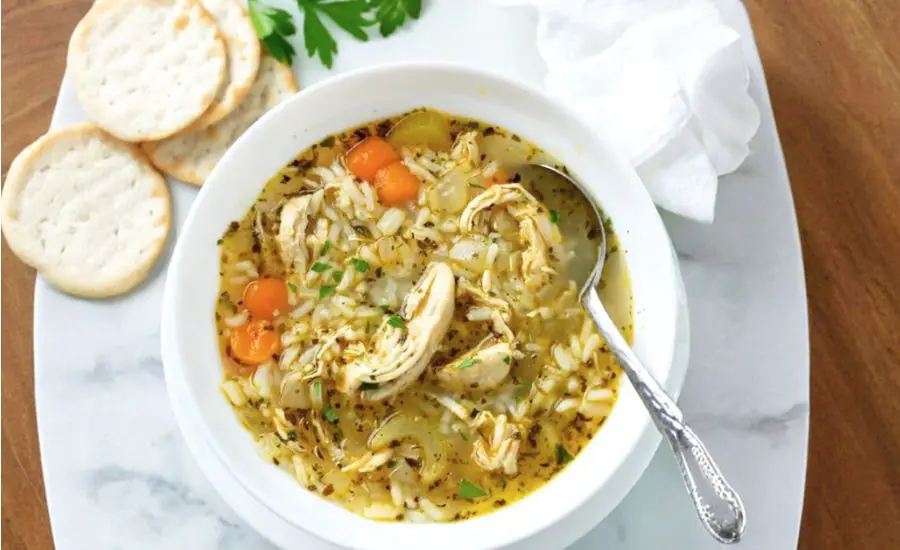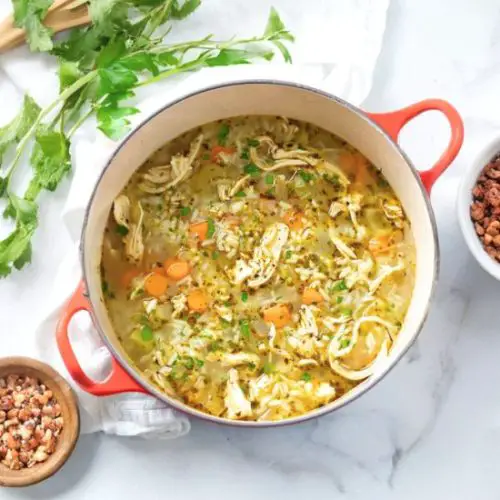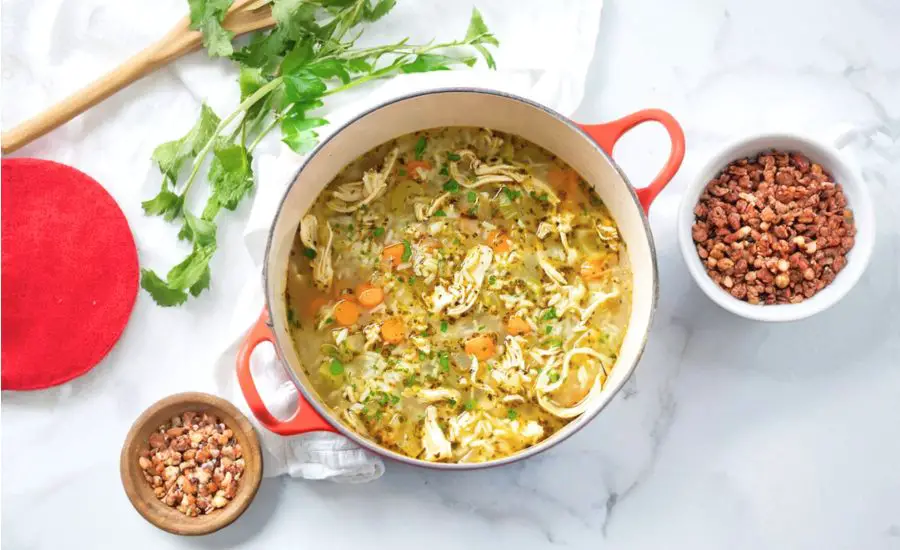All products are selected by our editorial team for quality. If you buy through our links, we may earn a small commission at no extra cost to you.
This Chicken and Rice Soup is a comforting, wholesome meal that combines tender chicken, hearty rice, and vibrant vegetables in a savory, flavorful broth.
What makes this recipe stand out is its balance of taste and nutrition—high in lean protein from chicken, fiber from carrots, celery, and onions, and low in saturated fat.
The rice is cooked separately to prevent it from soaking up too much broth, keeping the soup perfectly balanced and allowing for convenient meal prep or freezing.
With simple seasonings like basil, thyme, and a touch of mustard powder, the soup is bursting with flavor without being overpowering.

Quick to prepare, satisfying, and versatile, this soup is ideal for weeknight dinners, lunch prep, or cozy comfort food on chilly evenings.
Must-Have Tools for Perfect Results
Large Soup Pot
Ideal for gently simmering the chicken and vegetables. Its deep capacity ensures even cooking and is perfect for soups, stews, and sauces year-round.
Medium Saucepan
Essential for cooking rice separately. Its compact size allows precise heat control, producing fluffy rice every time, and doubles as a versatile pot for grains, sauces, or small-batch soups.
Chef’s Knife
Perfect for dicing vegetables quickly and efficiently. A sharp, high-quality knife saves prep time and improves safety, making it a staple in any home kitchen.
Cutting Board
Provides a stable surface for chopping onions, carrots, and celery. Protects countertops and ensures hygiene—an indispensable tool for any recipe preparation.
Slotted Spoon or Tongs
Useful for lifting chicken from the broth without losing liquid. Also versatile for straining or serving soups and stews cleanly.

Hearty Chicken and Rice Soup
Equipment
- 1 Large Soup Pot
- 1 Medium saucepan
- 1 Chef’s knife
- 1 Cutting board
- 1 Slotted Spoon or Tongs
Ingredients
Seasonings:
- 1 teaspoon dried basil
- ½ teaspoon dried parsley
- ½ teaspoon dried oregano
- ½ teaspoon dried thyme
- ½ teaspoon mustard powder
- ¼ teaspoon black pepper
Soup:
- 2 tablespoons butter
- 1 small yellow onion diced
- ½ cup diced carrots
- 2 ribs celery diced
- 3 cloves garlic minced
- 5 cups chicken broth
- 1 teaspoon soy sauce
- 1 teaspoon hot sauce
- 1¼ lb. bone-in chicken breast or thighs
- Fresh parsley for garnish
Rice:
- 1½ cups chicken broth
- ¾ cup uncooked white long-grain rice or 2¼ cups cooked rice
Instructions
- Prepare the Vegetables: Begin by washing, peeling, and chopping all your vegetables. Dice the yellow onion into small, uniform pieces so it cooks evenly. Slice the carrots into small cubes for a tender texture, and chop the celery into evenly sized pieces to maintain a pleasant bite. Mince the garlic finely to release its natural oils and flavor. Having all your vegetables prepped before turning on the heat ensures a smooth, stress-free cooking process.
- Melt Butter and Sauté Vegetables: Place a large soup pot over medium heat and add the butter. Once melted, add the diced onions, carrots, and celery. Stir frequently for about 4 minutes until the vegetables become fragrant and slightly softened. Add the minced garlic and sauté for an additional minute, just until its aroma fills your kitchen. Avoid letting the garlic brown, as this can create a bitter taste.
- Add Seasonings: Sprinkle in the dried basil, parsley, oregano, thyme, mustard powder, and black pepper. Stir thoroughly to coat the sautéed vegetables in the seasonings, allowing their flavors to bloom. This step builds the foundational flavor profile of your soup, ensuring a rich and well-balanced broth.
- Introduce Liquids and Chicken: Pour in 5 cups of chicken broth, then add the soy sauce and hot sauce for subtle depth and flavor enhancement. Carefully add the bone-in chicken breast (or thighs), ensuring they are fully submerged. The chicken will infuse the broth with natural juices, creating a savory and nourishing base for the soup.
- Simmer the Chicken: Bring the soup to a gentle, barely noticeable bubble over medium-low heat.Cover the pot partially and allow the chicken to cook slowly for 15–20 minutes. Cooking gently is key—boiling the chicken at high heat will toughen the meat. Occasionally skim any foam or impurities from the surface for a clear, flavorful broth.
- Shred the Chicken: Once the chicken is fully cooked and tender, carefully remove it from the pot with tongs or a slotted spoon. Place the chicken on a cutting board and use two forks to shred it into bite-sized pieces. Discard the bones, then return the shredded chicken to the soup. Stir gently to combine and allow the chicken to absorb the surrounding flavors.
- Cook the Rice Separately: While the chicken simmers, prepare the rice in a separate medium saucepan. Bring 1½ cups of chicken broth to a boil over medium-high heat. Stir in ¾ cup of uncooked long-grain white rice, ensuring each grain is submerged. Return to a boil, then reduce the heat to low, cover tightly, and simmer for 15 minutes. Turn off the heat and let the rice sit, covered, for 10 minutes.This resting period allows any stuck grains to loosen and ensures perfectly fluffy rice.
- Taste and Adjust Seasoning: Return to the soup and taste the broth. Add salt as needed to suit your preference. The soy sauce, hot sauce, and mustard powder have already enhanced the flavor subtly, so adjust seasoning carefully.
- Assemble the Soup: To serve, spoon a portion of the cooked rice into individual bowls. Ladle the hot chicken and vegetable soup over the rice. Alternatively, if you plan to eat immediately without storing leftovers, the rice can be added directly into the soup pot for a one-pot experience.
- Garnish and Serve: Finish with a sprinkle of fresh parsley for a vibrant, fragrant touch. Serve immediately with optional accompaniments such as oyster crackers or crusty bread for added texture. This comforting soup can also be portioned into airtight containers for convenient meal prep or frozen for up to three months.
Notes
- Cook the rice separately to prevent it from absorbing too much broth, keeping the soup balanced and making meal prep easier.
- Use bone-in chicken breasts or thighs for richer, more flavorful broth; boneless works fine but adds slightly less depth.
- Low and slow simmering keeps the chicken tender and juicy. Avoid boiling.
- Soy sauce, mustard powder, and hot sauce are subtle flavor enhancers, not meant to overpower the soup.
- This soup freezes exceptionally well; store rice separately from the broth to maintain perfect texture.
- Fresh parsley adds a burst of color and freshness; optional garnishes like oyster crackers enhance texture and flavor.
- Feel free to swap in other long-grain or brown rice varieties, adjusting cooking time and liquid as needed.
Chef’s Secrets for Flavorful Soup
The key to a rich, savory soup lies in building layers of flavor gradually.
Start by sautéing the onions, carrots, and celery in butter—this softens the vegetables while releasing their natural sweetness.
Toasting the garlic just slightly before adding the liquids unlocks its aromatic depth.
Choosing bone-in chicken adds natural gelatin to the broth, giving it body and richness.
Simmering gently over low heat preserves the meat’s tenderness and allows flavors to meld beautifully.
Using seasonings like mustard powder, soy sauce, and a touch of hot sauce creates subtle complexity, enhancing the soup without dominating it.
For an extra touch, consider adding a splash of lemon juice or a pinch of smoked paprika when serving to lift the flavor profile even more.
Serving Suggestions for Every Meal
This Chicken and Rice Soup is incredibly versatile.
Serve it over freshly cooked rice or add the rice directly into the pot for a comforting one-pot meal.
Pair it with crusty bread or garlic toast for a satisfying lunch or dinner.
It also makes a hearty accompaniment to a light side salad, roasted vegetables, or a simple sandwich.
For cozy family meals, add a sprinkle of grated Parmesan or a few fresh herbs like thyme or chives.
Individual portions can be packed into mason jars for portable lunches, making it ideal for busy weekdays or school meals.
Storage Tips for Longevity
Proper storage ensures your soup remains fresh and flavorful.
Refrigerate leftover soup in an airtight container for up to three days.
If freezing, portion the soup and rice separately to maintain perfect texture—rice tends to absorb liquid over time and can become mushy if stored together.
Thaw frozen soup overnight in the refrigerator and gently reheat on the stove over low heat to preserve tenderness.
Stir occasionally and adjust seasoning if needed before serving.
This method ensures you have ready-to-eat, nourishing meals anytime without sacrificing quality.
Frequently Asked Questions About Soup
1. Can I use leftover or rotisserie chicken?
Yes! About 2 cups of cooked chicken can replace raw chicken breasts. Add it to the pot and simmer for 15 minutes to blend flavors without overcooking.
2. Can I make this soup in a slow cooker?
Absolutely. Sauté vegetables first, then add seasonings, chicken, and broth. Cook on low for 6 hours or high for 4 hours, shredding the chicken before serving.
3. What type of rice works best?
Long-grain white rice gives a fluffy texture, but brown rice or jasmine rice can also be used. Adjust the cooking time and liquid according to the package instructions.
4. Can I make this recipe low-sodium?
Yes, use low-sodium chicken broth and reduce or omit the soy sauce. You can season with additional herbs and spices to maintain flavor.
5. Can I add other vegetables?
Definitely! Peas, green beans, zucchini, or even corn work beautifully. Add harder vegetables early during cooking and tender vegetables later to ensure perfect texture.
This recipe is inspired by thecozycook and has been carefully refined to enhance clarity, streamline preparation steps, and ensure accurate results. We’ve also included health benefits, nutritional highlights, and Must-Have Tools to help you get the best results every time you cook.


